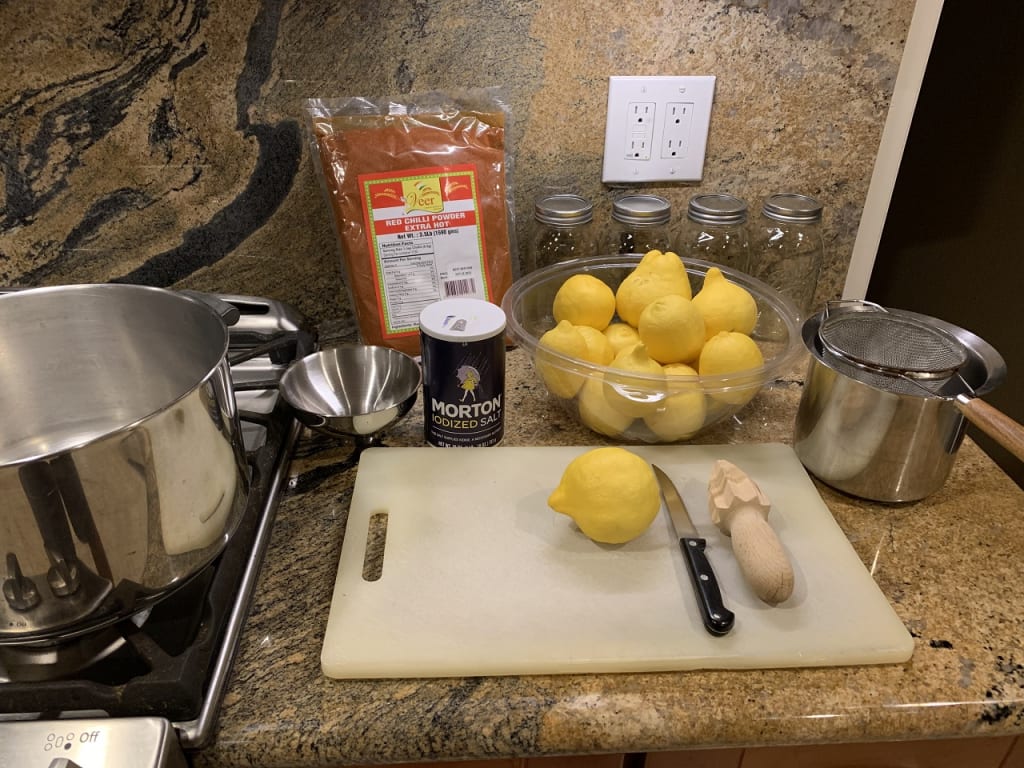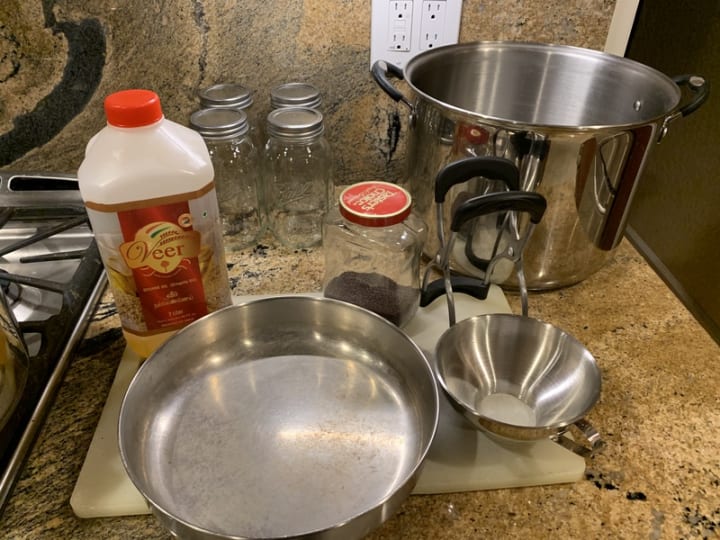RECIPE: South Indian Lemon Pickle
This homemade delicacy is a condiment for all occasions

I have grown up enjoying lemon pickle as a kid and even today, I look forward to its taste in the creative ways I add it to my food. It bears mentioning that the South Indian style pickle is generally too hot and spicy to consume directly. It needs to be added as a condiment, in small quantities, to the main food.
I am fortunate to live in California where lemons grow well. We have a lemon tree in the backyard and I have made many batches of the lemon pickle over the years. You can use store-bought lemons too.
The beauty of it is that with proper canning, the pickles made can be stored at room temperature for a very long time, from months to even years, as long as the seal holds. Let’s take a look at the simplest recipe I follow to make this delicacy.
Variations to this are possible to make the taste further refined and nuanced, but this is the core recipe. I never found a reason to deviate from it.
Ingredients
Lemons – 10-15 (Makes 2-3 quarts of pickle)
Extra Hot Chilli Powder – 1/4 cup per quart of pickle made (adjust to taste)
Salt – 1/4 cup per quart of pickle
Sesame Oil – 1/4 cup per quart of pickle
Turmeric Powder – 1/2 tsp
Black Mustard Seeds – 1/4 cup
Directions - Condensed
- Remove all the pits from washed lemons.
- Cut lemons into small pieces.
- Collect all lemon pieces with all the juice into a stockpot and add turmeric. Stir well and bring to a boil, adding water if needed.
- Let it simmer for 10 minutes.
- Remove from heat and let cool.
- Add salt and chilli powder and mix well. Cover the pot.
- Let it soak overnight for 12-24 hours. Continue after the soaking is complete.
- Start heating the sesame oil in a frying pan. Pop the mustard seeds in hot oil, partially covering the pan.
- Transfer the hot oil into the stockpot and stir to mix it well.
- Fill clean Mason jars with the pickle mix, leaving 1/4 inch air space on the top. Make sure there is no pickle mix on the rims of the jars or outside.
- Secure each jar with its lid and the ring. Screw the ring on hand-tight.
- Load the filled jars into a canning pot and fill water to be above the lids, submerging the jars completely.
- Bring the canning pot to a boil. Let the water simmer for 10 minutes.
- Use canning tongs to remove the jars from boiling water onto a cooling rack. Take care not to touch the rings or the lids as the jars cool down.
- Listen to the lids pop down into a seal.
- The jars are ready to be stored!
Directions - Detailed
Day 1
Wash the lemons well and remove all surface dirt.
Cut each lemon in half and remove the pits. I generally use a handheld wooden lemon juicer to drain the pulp and juice into a sieve over a pot. This makes it easy to fish out the pits and not lose the pulp and any juice along the way.
Cut the cored shells into small pieces and collect them in a stockpot. After all the pits have been removed, transfer the pulp and juice into the stockpot. Add a little water if it is too thick.
Add the turmeric powder and stir well.
Bring the stockpot’s contents to a boil. Then let it simmer for 10 minutes.
Remove from heat and let the pot cool.
Add the salt and chilli powder and mix well.
Cover the stockpot and let it stand overnight for 12-24 hours. Stir the contents periodically and mix them well.

Day 2
In a frying pan, add the sesame oil and start heating. Add some of the mustard seeds and wait for them to pop. Once the initial seeds pop, add the rest of the mustard seeds and cover the pan with a slight opening. You can hear the seeds pop vigorously. When all the seeds finish popping, turn off the heat.
Transfer the hot oil into the stockpot and stir to mix it well.
Using the canning funnel, start transferring the pickle mix into the Mason jars. Leave a 1/4 inch air gap on top in each jar. Make sure the rims of the jars are clean and don’t have stray pickle mix on them. Wipe it clean if necessary.
Secure each jar with its lid and the ring. Screw the ring on hand-tight. Place all the jars in the canning stockpot and fill water in the pot to above the top of the lids. The bottles need to be fully submerged throughout the canning process.
Heat the canning pot and bring the water to a boil. Let the water boil for 10 minutes. Remove heat.
Using canning tongs, lift each jar and place it on a cooling rack on the countertop. Do not touch the lid or the rings, even after they start to cool.
One by one, within a few minutes, you should hear the lids pop down to seal, due to the vacuum created by the cooling.
After all the lids have thus been sealed, unscrew the rings to see if any debris needs to be cleaned on the outside of the jars. Clean the rings and the grooves on the jars if necessary. Screw back all the rings, hand-tight, to get them ready for storage.
At this time, if you apply slight pressure on the center of the lid, there should be no movement. All the seals should have been made by the cooling. If any jar had a lid that hadn’t popped down, store it in a refrigerator and earmark it for consumption sooner than later.
Any jar that has been properly sealed is ready for long-term storage!

Consumption
The South Indian Lemon Pickle is a great condiment to add to any meal. The traditional, classic, use is in adding it to a course of plain yogurt and rice mixture. But you can let your imagination fly in adapting it to your taste.
For example, I used to drive my wife nuts by adding it to my bowl of oatmeal in the morning, after I added some milk to it. Proof that you can invent your own comfort spot in how you can add it to your meals.
The South Indian Lemon Pickle is truly a condiment for all occasions!
This is an adaptation of the original post at PVenkatRaman.com.
About the Creator
P. Venkat Raman
I write on diverse topics such as Personal Development, Travel, Finance, Gardening, Food, etc. I am a Vocal.Media member since Oct 2021.
Enjoyed the story? Support the Creator.
Subscribe for free to receive all their stories in your feed. You could also pledge your support or give them a one-off tip, letting them know you appreciate their work.






Comments
There are no comments for this story
Be the first to respond and start the conversation.